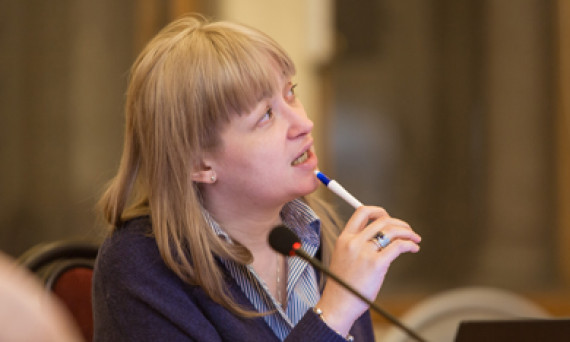On December 23, as part of the interdisciplinary seminar “Care Regimes for the Aging Citizens” and the EUSP Department of Political Science and Sociology’s Gender Studies Program, Zhanna Chernova (Doctor of Sociology, Higher School of Economics-St. Petersburg) delivered a lecture.
Researchers began to take an interest in issues of care in the 1980s and 1990s, when it was seen primarily in the context of parenting. This talk discusses three approaches to conceptualizing care that have been established in scientific literature.
First of all, researchers regard the category of care as a specifically female experience. Care is gendered, and its implementation is generally a positively-colored experience organized by certain norms and rules. Motherhood is one of the primary experiences that fit this approach. The American researcher Arlie Hochschild writes about how women are prescribed to feel love and affection toward children on the basis of the various positive ideals of motherhood.
In the second approach, care is defined as a specific type of relationship that emerges between those who provide and those who receive it, based on trust and altruism. Care ceases to be viewed as an exclusively female experience and comes to be understood as a specific type of relationship between people that can be situated not only within the family, but within the public sphere as well.
The third trend for conceptualizing care was developed by researchers studying social policy. Here, the category of care is no longer thought of as a specifically female experience defined by ethical categories. It is viewed as categories of work that may occur outside the home and may be paid for. The basic issues considered in this approach include how the government answers to the demand for care in implementing social policy; how the institutionalization of care occurs; whether or not it is paid work; and whether it is formal or informal. Researchers in this third approach view social policy of the 1990s as a solution to care deficit that emerged in Western society as more and more women gained professional employment. The answer to the question of care distribution—that is, who is the primary care provider, and where and on what conditions care is provided—depends on the welfare state’s mode of social policy.
Meanwhile, a lacuna exists in the comparative studies on the implementation of care depending on the type of welfare state on which G. Esping-Andersen’s classifications are based.
British researcher Jane Lewis proposed the idea of “care regimes” for analyzing social policy in terms of caring for aging people. This notion allowed for the construction of an analytical framework that includes not only a study of institutional conditions, but also society’s dominant ideas, norms and the gendered aspects of care relations. Depending on who receives care, this category helps to reveal a different configuration of its regulations and ideals.
In the late 1990s and early 2000s, reductions in state support to needy categories of citizens (single mothers, the elderly, the disabled, etc.) due to the attracting the funds from civil society, the market and families themselves made researchers speak about a “care deficit” (A. Hochschild’s term) at the institutional level. In parallel there also occurred a reduction in the “volumes” of care at the level of individual families. This was associated with the liberalization of the marital sphere, later ages for marriage and childbearing, changing patterns of professional employment and the increasing economic activity of women, an aging of population, and the phenomenon of the so-called “sandwich generation,” (i.e. women caring for both children and aging parents). This made the issue of women’s overlapping professional and familial responsibilities all the more relevant. Arlie Hochschild called this phenomenon the “stalled gender revolution.” As the gender roles of women have transformed (changing their professional and familial roles, allowing them to control their own reproduction, achieving economic autonomy), the gender roles of men have remained the same and there have been few changes in their behavior.
The researcher Monique Kremer sees a possible exit from this conflict in changing the structural conditions for the implementation of care. She proposes an expansion of T. H. Marshall’s concept of citizenship as a collection of political and social rights, including the right to provide and receive care. In this way, it is possible to expand the category of care beyond its consideration as a special type of relationship based on affection and altruism and carried out primarily by women in the private sphere of the family.
In a critical rethinking of G. Esping-Andersen’s concept of “decommodification,” Jane Lewis formulated a second way out of this stalled gender revolution. The above mentioned term shows that the extent to which the male worker is free from market pressure and the extent of his access to social services (health care, education, etc.) depend on his position in the labor market. In Lewis’ view, this concept is deficient since it applies exclusively to the male worker and doesn’t account for the importance of unpaid work to an individual’s well-being. Lewis proposed the term “defamilialization,” which is sensitive to gender and allows us to consider women as a special category of citizens who have the right to participate or not participate in fulfilling unpaid labor within the family. This, in turn, helps the state create institutional opportunities for men and women to choose between paid and unpaid labor.
Both Kremer and Lewis note that in order to support equal access to care, affordable and high quality care institutions must exist.
Natalya Sherstneva













